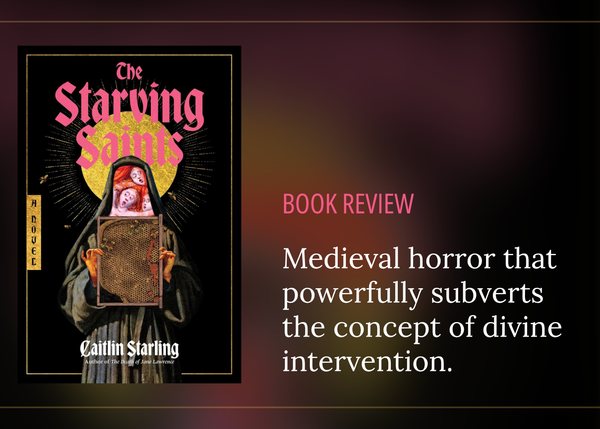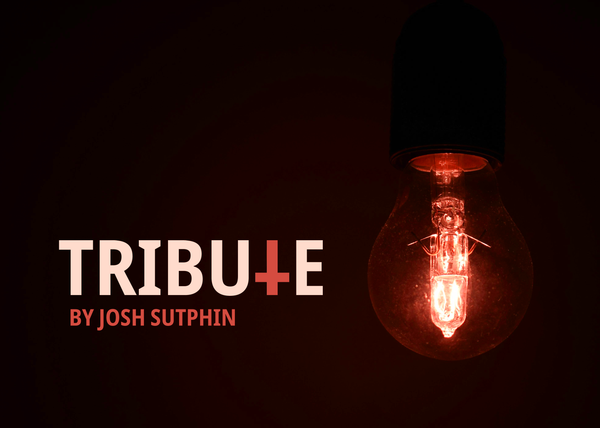Witness
A moody exploration of the aftermath of an obsessed writer's sacrifice to an ancient god.

Content warning: implied murder, including child murder
THE LITTLE RED brick house looms over its tiny square lot like a mountain. The walls bow under the sagging asphalt shingle roof, and the windows are all broken, their sills rotted away. Ash-colored weeds surround the foundation, gnarled black rhizomes spreading, reaching, as if to escape.
The porch is a heavy pinewood deck with a matching awning; it was charming once, after the owner and his son built it together by hand one summer, but now it is gray and mournful, the story of its neglect written in the cracks and furrows of its warped and weathered boards.
The front door, painted a vibrant mustard, is the sole feature that still appears as lively as it did when the house was first built, when the owner and his wife saw it and exclaimed, “This is the one!” The door stands ajar, beckoning, but nobody has entered, because nobody is now willing to approach this cursed place.
Even the yellow crime scene tape remains undisturbed.
Thin black filaments curl around the door frame, grasping, exploring, and a small voice, barely there, with a rasp like a breeze through dead leaves, beseeches from within:
Come to me.
The door opens into a gloomy living room of slate-colored bead board walls and faded oak floors. The musty smells of rotting wood and moldering upholstery permeate the still air. A worn, floral-pattern loveseat faces a pair of sad pastel armchairs. Between them, a low glass coffee table bears a Corelle ceramic mug, stained brown inside by the remains of its long evaporated contents, and a mess of unopened envelopes stamped “DUE ON RECEIPT” and “FINAL NOTICE” in red block letters.
Family photos decorate the wall above the loveseat: a pale young man with long blond hair alongside his wife and a beaming baby boy that grows from photo to photo into a sullen teenager as the smiles of his parents become increasingly forced. Delicate black stems snake up the wall and among the photos like sickly veins, and the frames hang anxiously askew.
A narrow hallway, lined with long tangles of the same strange growth, juts away from the living room toward the glow of a fluorescent bulb, toward a stairwell leading down, toward a sibilant whisper that snakes up from the bowels of the house, so subtle it could be mistaken for an echo from a dream:
Come to me.
Rooms flank the hallway on both sides, offering illusive escape from the quiet, but insistent, pull of that voice.
A small bedroom painted all in black: a twin bed with rumpled sheets; piles of laundry on the floor; posters of heavy metal bands—Iron Maiden, Slayer, Anthrax—haphazardly masking-taped to the wall; a beat-up boom box on a folding table, the table bowed under the weight of tottering towers of cassettes; a well-used electric guitar and a garage-sale amp carefully arranged in one corner like a shrine.
A master suite with faded floral wallpaper: an antique hand-carved Crucifix looming over a neatly-made four-poster bed; one nightstand bearing a gaudy Tiffany lamp and a well-worn leather-bound Bible sprouting dozens of tiny colored paper flags; the other, a mess of notebooks scribbled with inscrutable handwriting; a low wooden dresser on which an extensive series of Danielle Steel novels stands between a flower pot and a little wooden picture frame: a wedding photo of the pale, blond-haired man and his blushing bride with smiles as bright as their eyes.
The disembodied voice, with rising urgency, hisses up from below:
Come to me!
Sticky black cilia mat the landing, squirming like maggots under the subtle flicker of the bare fluorescent bulb. The stairs and the quivering excrescence descend together into a long basement room with a claustrophobic drop ceiling, no windows, and dirty beige carpet. A shaft of fluorescence slices down the length of the room from the stairwell, highlighting the remains of a wood-paneled cathode ray television hurled on its face in the middle of the floor, surrounded by a spattering of brown splotches.
A shabby oak entertainment unit covers most of one wall, floor-to-ceiling, all crooked cabinets and sagging shelves. Its central open space—where the TV once stood—is now a makeshift altar for a two-foot-tall pillar of obsidian carved into a malevolent demonic idol. Rows of spider-like eyes line an otherwise humanoid face framed by a pair of jagged tusks. The terrible head gazes skyward atop a grotesque distortion of a feminine form, its spine violently twisted into a pose of eternal agony. Its arms splay out toward the heavens, beseeching, with animal-like claws. Instead of legs, the awful body tapers and blends seamlessly into the trunk of a tree, from the base of which springs a mass of gnarled roots that spill across the altar like entrails.
The otherworldly whisper, now savage in its demand, susurrates from the idol itself:
I am Shegorah. Witness my tribute!
A long beige sofa squats against the wall across from the altar, its cushions all askance and its broken middle sagging visibly. A pair of bright yellow police evidence markers and two spray-painted outlines of bodies in upright, seated positions stand out in stark relief against huge rust-brown stains. Sickly black roots covered with wriggling cilia crawl up the sofa and spread over its surface like netting; where they were severed at the edges of the sprayed outlines, they’ve left behind dark, oily stains.
The roots gather at the base of the couch in a cluster, and that cluster snakes across the carpet to a door which stands ajar at the far end of the room. A thick puddle of putrescent slime covers the threshold, and from this, sprays of black filaments climb the jamb. A sickly yellow tint slices through the opening, forming a cross with the shaft of stark fluorescence from the stairwell.
The voice shrieks now from beyond the door:
The way is open. Come. Come!
Inside: a musty office with built-in bookshelves lining three walls. Gnarled black roots invade every surface; the spongy carpet squelches with their oily secretion. Black, anemone-like growths burst from knots in the roots, undulating in slow, synchronized time, exhaling spores that choke the air like smoke. From these spread ropy tangles of viscid tissue that permeate the bookshelves; the few books that remain are unrecognizable corpses, their spines eaten away by the malignant growth.
A heavy oak desk dominates the room, and on it a brass banker’s lamp hunches over a vintage black Remington typewriter, illuminating it like a museum piece. The typewriter is spotless and in perfect repair, the ribbon fresh, the classically circular keys piano black with gleaming chrome accents.
A thick stack of bright golden pages rests to the side. The topmost, a title page, reads in crisp, centered type:
THE TESTAMENT OF SHEGORAH
A True Account of the Word of SHEGORAH
transcribed by the hand of HER Most Faithful Servant
Most of the room’s built-in shelving sags under the weight of reams upon reams of golden paper and dozens of manuscript boxes, each labeled identically: nearly a hundred manually typed copies of the Testament. Unlike the blighted books, the manuscripts remain unviolated by the permeating pestilence.
The wall facing the desk is covered over with a chaotic collage of pages—yet another full copy of the Testament. This dramatic display surrounds an antique full-length mirror with an ornate wooden frame, perfectly integrating the reflection of the desk, the chair, and the typewriter into this monument to obsession.
The reflection in the mirror shifts and distorts, alternating with—no, combining with—another image, a portal into an impossible space: a citrine firmament, stricken with roiling black clouds and lashed by lightning; ash falling like corrupted snow upon a great ziggurat of burned brick and bitumen; a ten-foot-tall obsidian statue—the true, petrified body of Shegorah, imprisoned beyond Creation—her demonically tusked, spider-eyed head, her beseeching arms upraised in supplication to a terrible sky, her grotesquely twisted torso tapering to the trunk of a tree; the writhing mass of eldritch roots spilling out towards the mirror, through the mirror, malevolent fingers reaching across the office floor, up and over the desk, ensnaring and dragging it toward that nightmare realm beyond the wall.
In the reflection—only in the reflection—a man slumps over the desk, his skin pale as snow, his long blond hair shrouding his face. The roots grow over his limbs, over his shoulders, over his back, consummating his eternal bondage to the work, his ultimate union with the object of his worship, the apotheosis of his obsessive devotion.
Her word bellows forth from her petrified form, soaring across the cosmos, vomited up from beyond Creation:
Take up my Testament. Bear me unto the world!
This writer was a means to an end, a tool for Shegorah’s will. He was her witness. There will be others.
There is one now.

Afterword
I BRIEFLY LIVED in a little red brick house near Salt Lake City. I loved that house, and I had so many cool projects planned for it, but when I bought it, I had no idea how quickly my life was about to change. By the end of that same year, I was preparing to move again—this time to the Seattle area, for a new job—and then two months after that, COVID hit.
My memories of that house became a graveyard of unrealized dreams, haunting me like an obsession. Witness grew from that feeling.





